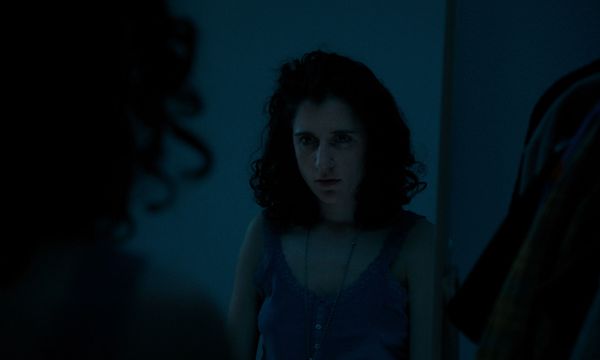 |
| Ellie Kendrick in Attachment Photo: Soeren Kirkegaard |
Now screening on Shudder, Attachment is one of the most successful of the various films shot under lockdown conditions. It’s set almost entirely within the confines of one house, with a small but high quality cast: rising Danish star Josephine Park as heroine Maja, Game Of Thrones’ Ellie Kendrick as her girlfriend, Leah, and The Killing’s Sofie Gråbøl as Leah’s deeply troubled mother, Chana. The two young women have recently fallen in love and relocated to London, but Chana takes the clichés of the Jewish mother to a new extreme in her efforts to control her daughter’s life – and all for a reason which won’t become clear until it may already be too late. When I met writer/director Gabriel Bier Gislason yesterday, I asked him if the project began with an interest in the London Hasidic community, with the drama between the three women or with the supernatural element with gradually takes shape, drawing on ancient Orthodox Jewish lore.
“Sort of none of the above,” he says. “It had two points of origin. When I was in film school, I had this notion that I'd really like to try and make an irreverent kind of Jewish horror movie. The thing that I enjoyed so much in a lot of the horror movies I saw growing up was that, especially the ones that would draw on religious kind of” – he pauses – “for lack of a better word, mythology – or liturgies, or ritualistic notion, is that they would do it in a really interpretive, liberal way, like here are all these things that are part of this cultural capture, and we're going to take the parts that work for the story and fill in the gaps with some fun make-believe, because it's really all in service of telling a story that relates more on a human level.
“I hadn't seen anyone do that with Judaism. And being a Jew, I grew up reading a lot of Jewish fiction – Isaac Bashevis Singer is really big influence on me – that had this really fun, never very serious, also freely interpretive approach to this media. That approach I thought was so interesting. So anyway, that was a vague idea. I didn't have a story – it was more like a tone or a world I wanted to step into independently of that.
“In the summer of 2018 – so, Josephine, who plays Maja, she is one of my best friends since high school, and she just finished drama school and I was sort of wrapping up film school, and we went out and we got very, very drunk. And then she started telling me these really funny, crazy, over the top stories she never really told me before. Basically like she had a girlfriend. They were both between apartments so her girlfriend was like, ‘Why don't we just move into my mom’s? She's got room. We can stay there for a month and it'll be cool.’ And they did, and it was not.
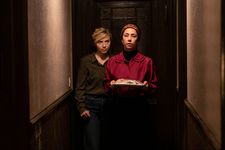 |
| Josephine Park as Maja and Sofie Gråbøl as Chana Photo: Soeren Kirkegaard |
“It was really, really over the top, and also weirdly sweet in some way. And in my drunken reverie, I was just like, ‘Oh my god, I have to write you this movie, and I'll make you a star and you will be famous!’ She did manage to become a star here in Denmark, but through no work of mine whatsoever. But anyway, that idea kept sticking in my head. What would it be about? And how would I go about telling that story? And then the Jewish angle came back and I started thinking about the trope of the Jewish mom, and how it's always, you know – to me, the best depiction of it is Shelley Winters in Next Stop, Greenwich Village. Insanely overbearing, domineering. Everything is a matter of life or death. And I thought, wouldn't it be funny if you made a movie where it actually is all about life and death, unbeknownst to the protagonist, and actually the chicken soup is a really pivotal piece of the puzzle?
“Once that clicked into place, the specifics of the story that Josephine told me fell away because it didn't work for that world, but that structure of those three women in a house together, that felt like such a good vehicle to explore those things because at the end, they all came at the same thing, which is, you really do go through a lot for the people you love, you push yourself a lot, and often the people who seem to be demanding the most of you are the ones who are also giving the most of themselves. It all clicked together and so that became the script.”
So wonderful role, the role of the mother, because most of the way through, she just seems like an antagonist. And she seems really hard to put up with or to be around. But we have to understand her a bit even early on, because so much depends on that at the end, when we do find out what she's been going through. So I mean, you have a dream cast in this film, but how did that come together? And how did you work on that character.
“So Josephine was obviously just baked into the film. I was always writing for her, it was always going to be her. And not when I was writing the treatment, but the moment I actually had to start writing the first draft and I had to try to hear voices in my head, Sophie, who I've known for a very long time, just immediately came to mind. She relished the idea that she got to play someone who's really unpleasant or really frustrating at times. She's never played like a villain or someone who may appear as a villain before, but she has this great history of playing all these really incredibly difficult, complicated characters. But she always brings this really deep sense of humanity to them.
“There's so something so incredibly human to the most annoying things her characters will do. That was really crucial here, because it was really important that her character always be a bit inscrutable. And the more frustrating, and difficult I would make her, the more important it was that it was still performed by someone who had always had that hint of something human underneath, because if you took it too far in one direction or the other, and you would start placing her, whether correctly or incorrectly, too firmly in one category, and that was really important to avoid. So I wrote it for her, and then by the second draft, I showed it to her, and then she signed on.
“Ellie was like a miracle. Also just an incredible collaborator. So Ellie's role was the only one that I didn't have anyone in mind for. I wrote Lev with David (Dencik) in mind and I'm fortunate that he signed on as well. But Leah, I had no idea. I knew some actors in the US from film school. I knew some actors here in Denmark. I needed someone English. I didn't really have anyone that I had a relationship to. And then this thing happened where my partner, she lives in Vancouver and I was visiting her, and one of her colleagues in the film studies at the University of British Columbia, he's English. I was telling him about the project and he mentioned ‘Oh, you should check out Ellie Kendrick, she was in this great indie film called The Levelling. I made a note of that and then the next morning I woke up to an email from the casting director in London, and Ellie was the first name on the list. And I checked out her reel and I was just like, ‘Oh, yeah, this is great.’
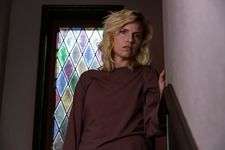 |
| Josephine Park in Attachment Photo: Soeren Kirkegaard |
“I spoke to a number of people, all of whom were great. Not all of them felt totally right. I had this feeling about Ellie that she was going to be the one the role. And then I had it down to a couple of people who I had said I need to do chemistry reads with them and Josephine...It also had to do with Ellie's first notes on the script. Every single thing she said about the script was 100% accurate. She'd see weak spots, but it was all really productive. It was really fun ideas...So we did the Zoom. They were really funny, even excruciatingly, and then, to their embarrassment, I made them do a bit of improv with me over Zoom just because it's fun to see if people like it, whether it’s awkward, whether people think it's fun to think on their feet a bit, and they were really good at it. It was just great.”
Going back to what he was saying about Jewish horror, I note that the film is full of little clues which people familiar with Jewish culture will get but which are likely to be invisible to a general audience. How did he get the balance right in guiding these two different audiences through the mystery?
“I did spend a lot of time early in the process of trying to make things clear on explaining things,” he says. “And then at certain point, I was like, you know, what it is making it is clunkier. I'm not teaching anyone an accurate lesson about anything in Judaism. This is a highly mediated through my own sensibility and sense of humour and a desire to take the same liberties that people from other religious backgrounds have taken with their own heritage. It's just not my job to educate anyone, I'm going to have some stuff in there, I think broad strokes, I'm hoping people will be able to keep up. There will be something fun for the people who get some of the extra stuff. For the ones that don't, it's probably not going to get in the way of the movie at large.”
We talk about mental illness as a theme in the film. Is Chana mentally ill? If so, is that something to run away from or something which means that she needs additional attention and care?
“I didn't want it to be used as a weird trope for instability,” he says. Like, where mental health becomes some weird metaphor for itself, which I always find to be quite frustrating. So to me, it was important that, like, clearly, Hana, in many ways, is not doing too well. And also, as we come to learn, it's been a very rough life and she is facing something quite unmanageable.
“At the outset, when I was originally developing it, I was I had this idea that – for lack of better references and in no way making light of his crimes and everything, but like, Polanski in The Tenant, they built furniture that was disproportionate to the size of the room to keep doing these things to fuck with the sense of perspective, to make them seem more out of whack. And I was originally going to do that with mine. And then, without going too much into it, as I think a lot of people did during the pandemic, I had to deal with some mental health issues of my own that I hadn't really wanted to reckon with as seriously as I should have until the rubber of a global pandemic hits the road of what was a normal life.
“And so I had this feeling like, ‘Oh, this isn't a thing I want to treat as a conceit.’ I wanted to have the shape of something that is a natural, real concern. that people would take seriously. But because the film is not about mental illness, I want to ultimately understand that a lot of that behaviour is rooted in something within the reality of the world. It’s true to how someone might behave under certain pressurised circumstances.”
Going back to what he said about the set, I ask him how the set dressing came together, because it’s full of wonderful details – this is definitely a film which people will want to watch more than once, looking for clues.
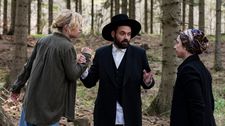 |
| Josephine Park, David Dencik and Sofie Gråbøl Photo: Soeren Kirkegaard |
“There's a crazy story about why this set even came about,” he says. “Originally we were hoping we could shoot the London scenes largely in London. Then, with just a very slim budget, that started becoming pretty impractical for a variety of reasons, but Covid made it physically impossible. It was fine. It was like a contained piece, not a lot of locations. So we spent a long time finding a house like a double for a London house. I lived in London for a long time, the production designer lived in London for a long time, we knew what we needed from the house to make it work. And after a while, we found a place.
“It was going to take some work, it was going to be hard, but we could make it work. And we spent most of our prep time – which is really precious time in film production. Every day has an enormous value to the production of the film. We spent a significant chunk of it figuring out just how to use this house. And then two and a half weeks before we go on set, the homeowner calls us and tells us that she's just discovered that what we're doing a horror movie. I don't know how she had it figured out, but she was – and she meant this quite literally – worried that we would curse her home. So we were just screwed. What do you say to that?
“So in two and a half weeks, because we didn't have time to find a new location, we just had to build a set on a stage for like, no money. And the fact that the production design team managed to do it in such a short amount of time with such a low budget is bananas to me. To this day, I can't believe that they pulled it off. But there were some definite benefits to it. Not that there's like a ton of flashy, elaborate shots in the film because we didn't have the time budget for it, but we knew certain camera angles would be great to have, certain blocking opportunities, so we could design the house around that a bit.
“We designed the kitchen we had for the first week so it was Maja’s kitchen and then when we had to shoot Chana’s scenes, we just flipped the kitchen around and redressed it. The thing that I said was really important is that I asked them to just clutter it as much as they could, and then I would come in and take take things out. Because what looks cluttered in real life in the frame might not actually look that cluttered and also, at a certain point, it could go too far and you’d start losing the details. Like I said, we put a lot of work into what specific details were there. So they just cluttered it, I came in and we walked through with camera.
“I had a great production design teacher at film school who taught me this thing of like, the more that you can get the sense that things can bleed out on the edges of the frame, the more people get a sense that what you're not seeing is even worse. So a lot of stuff we did in the kitchen, we had a sense of like, okay, we there's should be like a little bit of stuff here and there that you can't quite see where it goes, but you have a feeling like this continues into the rest of the house. I wanted it to have that feeling because I wanted the audience, when they thought about it later, once the film is over, to consider how many years you'd have to live like this, spent in all these different kinds of realities and realities and bizarreness, and how how worn down her life had become at that point. And I really wanted to suggest that it was so much worse if you got further into the house than what you just see in that beginning.”
Then at the end, everything opens up as we find ourselves in a new location out in the forest.
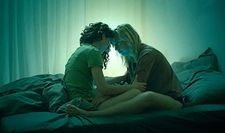 |
| Ellie Kendrick and Josephine Park |
“The location was fortunate in that it was my best friend - and now, because we're so close, also my brother – it's his family's country house. I've been coming to that house for years, and we were trying to figure out where to do this last bit, and again, our budget was tight. And I was like, ‘I know this house and it's really lovely, but it wouldn't take a lot to make it not lovely at all.’ And we went up there and it was just like, ‘Yeah, okay, we take that out and take that out, so that now it feels really creepy and uncomfortable.
“The forest is a little bit separate. It's in a different part of different part of the country. But yeah, it was one of those things where you try to take the budgetary restrictions and use them to advantage. Normally, with endless money, you'd be shooting nights and you'd be wanting to go into a really dark, creepy apartment or house or something like that. But because part of the fun of the film was always to play with the genres and the tones throughout the third act, what if it plays out in daylight in a little country house? Then when it starts taking a turn for the more sinister, it kind of creeps up on you. So that was where we went.”
He’s already at work on another genre film.
“Right now I have a couple of projects in the works, but the one that I'm primarily focused on is another Danish production. This one’s set in Iceland, but it's Nordisk Film. And it's actually written for Sophie. It’s loosely inspired by an Icelandic ghost story called The Deacon Of Dark River. I think it's both sadder and funnier than Attachment – it has real tragicomedy vibes. It's about death, loss, it's about this village of undead people, and the people who tend to them. I just pitched it at a festival in Sweden last week, and it went well, and I'm delivering the first draft any day now to the Danish Institute. They commissioned a draft. So fingers crossed we'll be shooting that sometime next year.”





















